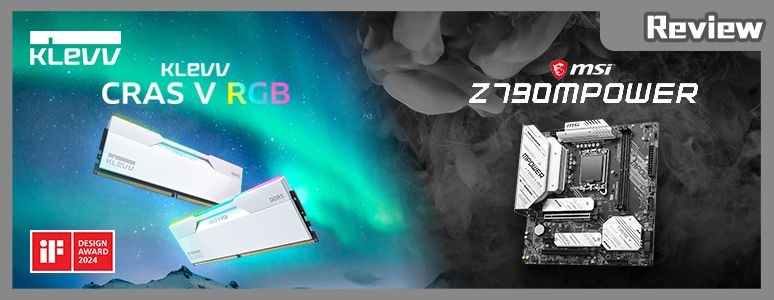
The KLEVV CRAS V RGB memory has undergone an exciting evolution, now featuring a 10-layer PCB and meticulously selected memory chips. This upgrade propels its speed to an astonishing maximum of 8400MT/s. It’s engineered for performance and aesthetic appeal, supporting one-click overclocking technologies like Intel XMP 3.0 and AMD EXPO. The memory’s design is further enhanced by its tone-on-tone white aluminum heat spreader paired with dazzling RGB lighting, earning it the prestigious iF Design Award in 2024. This combination of top-tier performance and striking looks makes it a standout choice.
Specifications:
- Memory Capacity: 16GBx2
- Memory Speed: 6400MT/s
- Memory Timings: 32-38-38-78
- Memory Type: DDR5 U-DIMM
- Voltage: 1.35V
- Easy Overclocking: Intel XMP 3.0 / AMD EXPO
- Dimensions: 133.3 x 44 x 8 mm
- Pin Count: 288 Pin
- Warranty: Lifetime Limited Warranty
This memory module is not just a powerhouse in terms of speed and reliability but also a testament to cutting-edge design and engineering, making it an ideal choice for gamers, content creators, and PC enthusiasts seeking both performance and style.
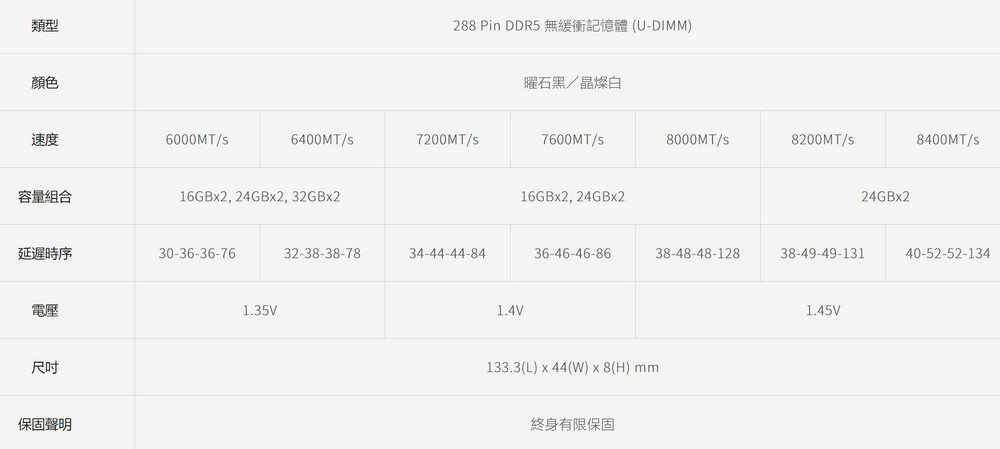
Unlock Next-Level Gaming Performance with KLEVV CRAS V RGB DDR5 Memory: Seamless Overclocking and Stylish Design
The KLEVV CRAS V RGB DDR5 Memory elevates your computing experience with seamless support for Intel XMP 3.0 and AMD EXPO technologies, offering gamers and enthusiasts effortless one-click overclocking. This feature allows users to unleash the full potential of high-performance memory effortlessly. In collaboration with leading motherboard manufacturers, KLEVV ensures compatibility through rigorous QVL (Qualified Vendor List) testing, guaranteeing a stable and reliable user experience.
This cutting-edge memory module utilizes a 10-layer PCB and carefully selected memory chips to achieve extraordinary frequencies. With an integrated PMIC (Power Management Integrated Circuit), it enhances power stability, while the On-die ECC (Error-Correcting Code) technology ensures operational reliability, maintaining high performance even under demanding conditions.
The newly launched Crystal White variant features a large area of white accented with a top portion in light grey linear perforated design. This aesthetic choice allows light to spill from the sides, illuminating the silver CRAS V RGB branding. The tone-on-tone color scheme showcases KLEVV’s commitment to fashionable aesthetics and robust cooling capabilities. With a height of 44mm, it’s compatible with mainstream air coolers, offering gamers more freedom in their setup choices.
The KLEVV CRAS V RGB DDR5 Memory is not just about performance; it’s about bringing style to your system without compromising on functionality. Whether for gaming, creative work, or daily computing, it’s designed to provide a seamless, high-performance experience while enhancing the overall aesthetics of your build.
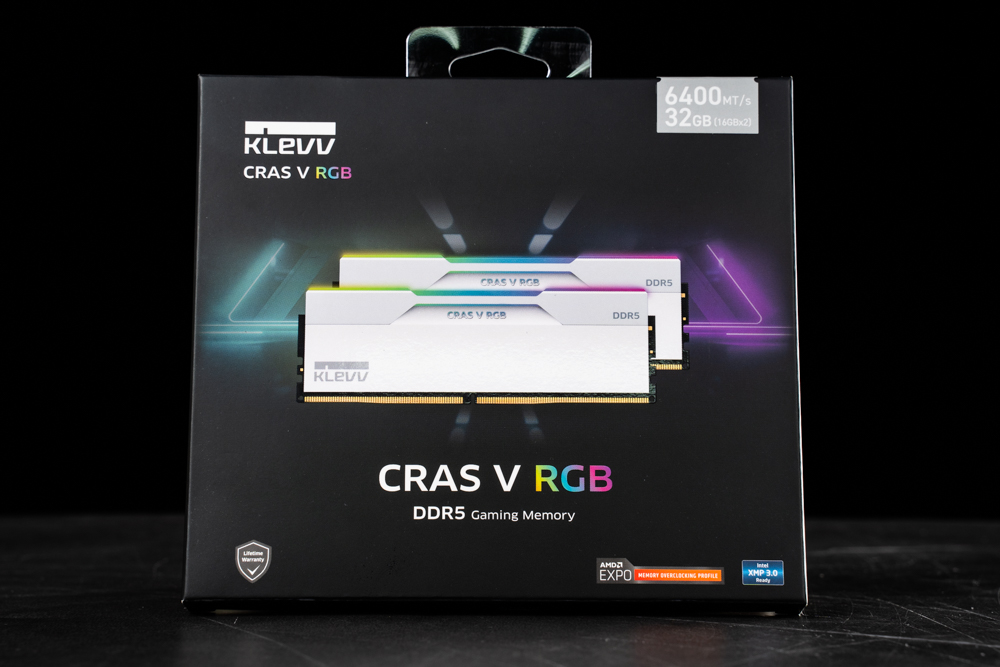
This is the packaging for the KLEVV CRAS V RGB DDR5 memory in a stunning Crystal White edition. The box displays the memory modules prominently at the front, highlighting their sleek white and silver design that matches the theme of sophisticated and high-end gaming components. The packaging also emphasizes key specifications like the impressive 6400MT/s speed and the substantial 32GB capacity (16GBx2), ensuring that potential buyers are immediately informed of the product’s high performance. The logos for AMD EXPO and Intel XMP 3.0 indicate support for these overclocking profiles, assuring compatibility and ease of use for customers. Moreover, the presence of the Lifetime Warranty seal underscores the brand’s commitment to quality and customer satisfaction. This product’s packaging has been carefully designed to attract attention and convey the premium nature of the memory modules within.
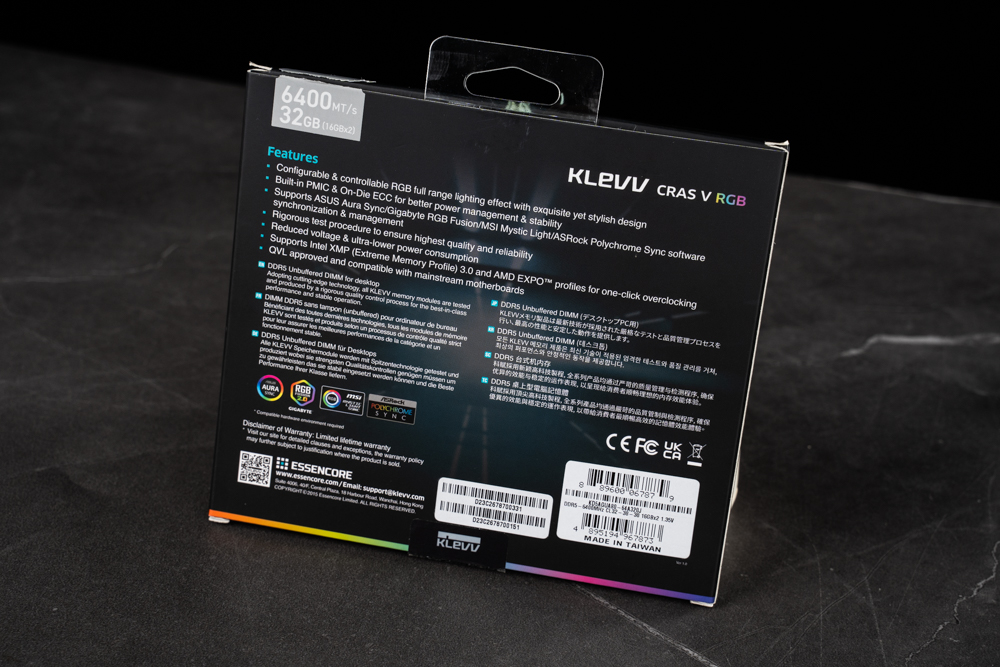
On the back of the packaging for the KLEVV CRAS V RGB DDR5 memory, there’s a concise list of features that highlight the product’s capabilities and compatibility, emphasizing its appeal to potential buyers. The package details the full range of technical features and support options for consumers, ensuring they are well informed about the product’s advantages:
- Configurable & Controllable RGB: Full-length lighting effect with a stylish design for personal customization.
- Built-in PMIC & On-Die ECC: Ensures high power management efficiency and operational stability.
- Synchronization & Sync Software Compatibility: Supports popular motherboard sync software like ASUS Aura Sync, Gigabyte RGB Fusion, MSI Mystic Light, and ASRock Polychrome Sync.
- Rigorous Testing & QVL Approval: Confirms compatibility with major motherboard brands, ensuring the product has been tested for reliability.
- Reduced Voltage Requirement: Operates at a lower power consumption for increased efficiency.
- Supports Intel XMP & AMD EXPO Profiles: Simplifies the overclocking process with one-click profile settings.
The packaging also reiterates the product’s speed of 6400MT/s and capacity of 32GB (16GBx2), which are key selling points for users looking for high-performance memory. Certifications and compliance marks like CE and UKCA are visible, indicating adherence to various regional regulations and standards, which can be an important consideration for international buyers.
Overall, the package is designed to provide all the necessary information while reassuring the customer of the product’s quality and compatibility with their system.
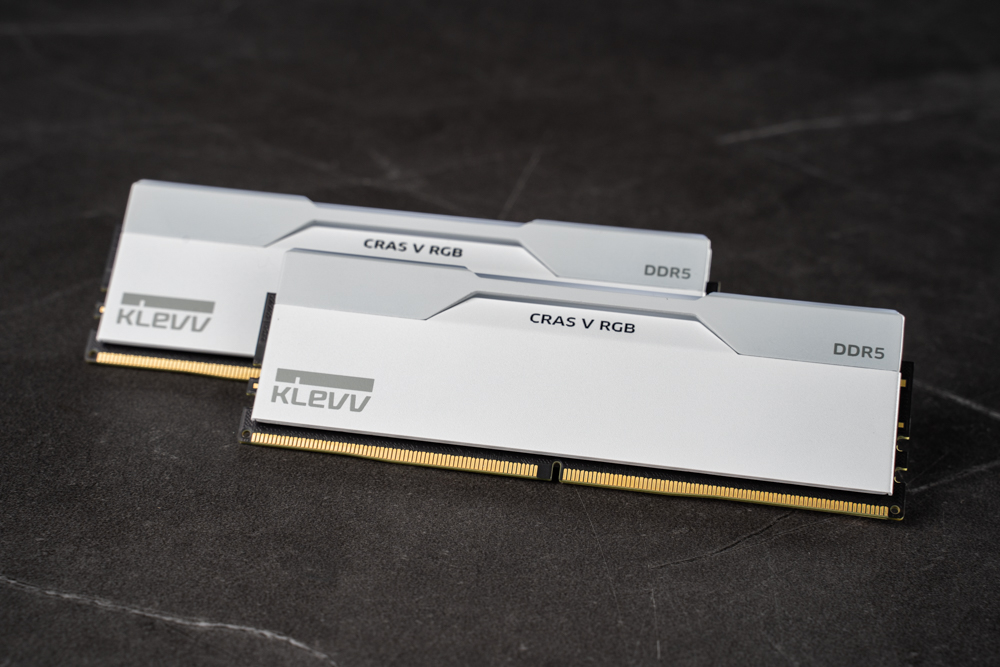
The memory modules displayed here exhibit the Crystal White color scheme of the KLEVV CRAS V RGB DDR5 series. The modules have a clean, white heat spreader with silver accents that underscore their sleek, modern design. The name CRAS V RGB is prominently featured, indicating the product line, while the DDR5 label makes it clear that these modules are of the latest generation of high-speed memory.
The aesthetics of these modules don’t just serve to enhance the visual appeal of a gaming setup; they also serve a functional purpose. The substantial heatsink is designed for effective heat dissipation, ensuring that the memory operates at optimal temperatures even when pushed to high speeds or during overclocked conditions. The overall design reflects a balance between high-performance specifications and a style that complements any PC build geared towards enthusiasts and gamers who prioritize both form and function.
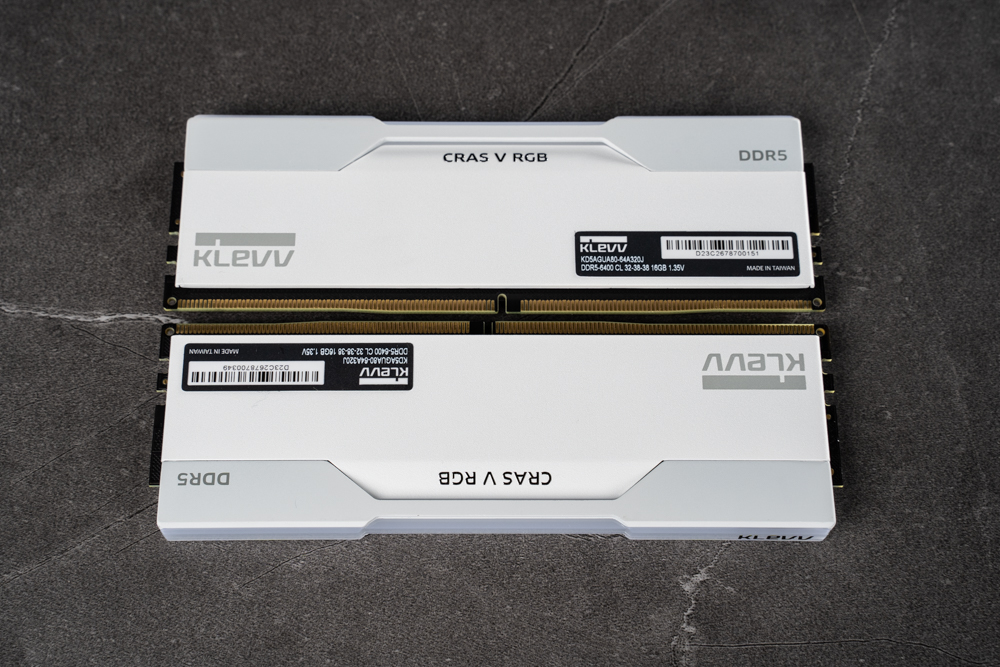
In this image, we see the KLEVV CRAS V RGB DDR5 memory modules flipped over, revealing the black label stickers on the backside. These labels are crucial as they provide detailed product information, such as the part number, specifications, and serial numbers, which are essential for inventory, warranty claims, and support. Notably, the labels confirm the memory’s capacity and speed, with a specification snippet indicating DDR5 6400 CL32-38-38-96 1.35V 16GB, a configuration suggesting high performance and reliability for demanding computing tasks.
Moreover, these labels carry the “Made in Taiwan” mark, indicative of the product’s manufacturing origin, which is often associated with high-quality electronics manufacturing. The strategic placement of the stickers does not detract from the module’s overall aesthetic, allowing for a sleek and unobtrusive look when installed in a computer system. The consistent branding, with the KLEVV logo visible, maintains the professional and premium feel of the product.
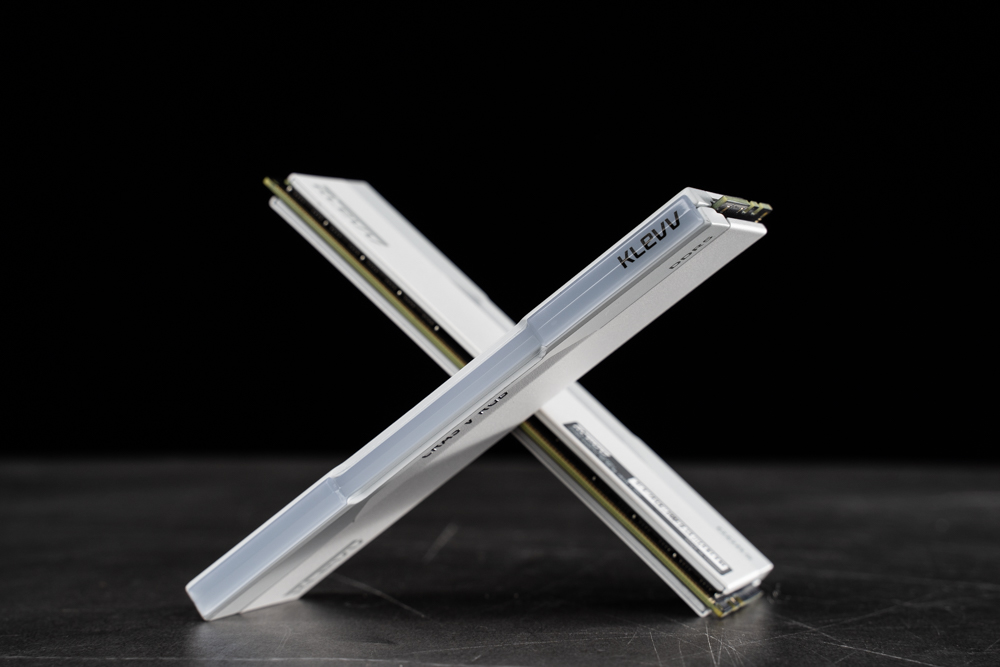
Here we have an artistic presentation of the KLEVV CRAS V RGB DDR5 memory modules, positioned in a cross shape that accentuates their design features. The top edge of each module proudly bears the KLEVV logo, a stamp of the manufacturer’s brand identity. This logo placement is not only an important branding element but also often visible through the window of a computer case, contributing to the overall aesthetic of a user’s PC build. The photograph emphasizes the memory modules’ sleek profile and the crisp, clean lines of the heat spreader design, reflecting the elegant and refined choice in styling for these high-performance components.
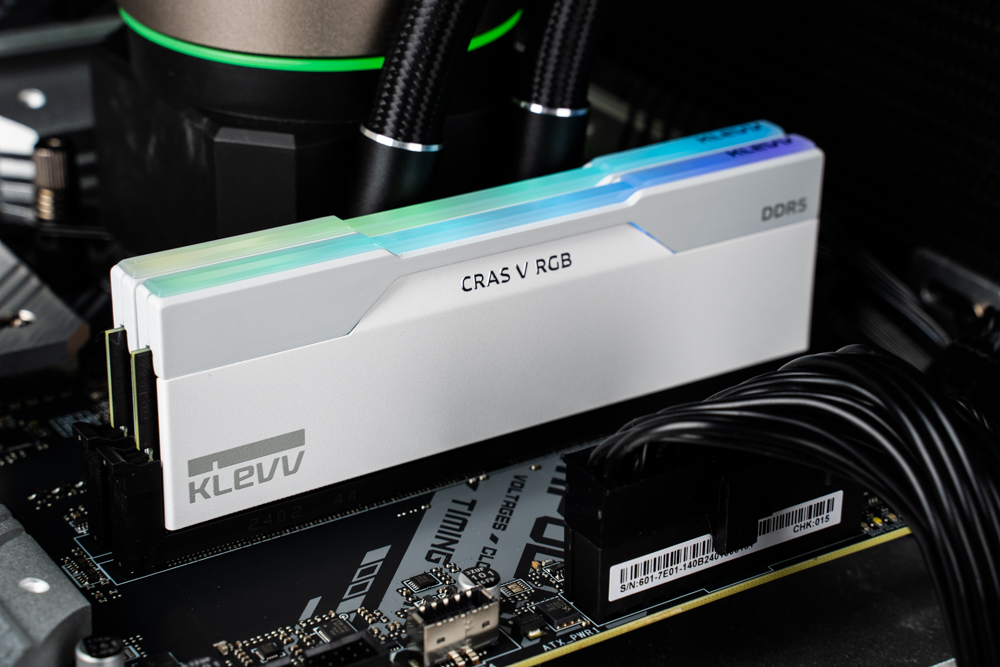
The image showcases the KLEVV CRAS V RGB DDR5 memory module installed in a computer motherboard, with its RGB lighting effects activated. The lighting emits a soft glow along the length of the module, displaying a range of colors that add a dynamic visual element to the computer’s interior.
The RGB illumination capability of the CRAS V RGB DDR5 allows for full-spectrum color control and synchronization with the major motherboard manufacturers’ lighting software, enabling users to create a personalized and immersive lighting experience within their setup. The ability to sync with lighting ecosystem software from companies like ASUS, Gigabyte, MSI, and ASRock means that users can seamlessly integrate the memory’s RGB effects with the rest of their system components for a cohesive and visually appealing effect.
This customization enhances the overall aesthetics of a gaming rig or workstation and allows for a personalized expression, whether one prefers a consistent color scheme or a vibrant, color-shifting display. It’s a feature that appeals not just to the performance demands of users but also to their desire for a setup that looks as good as it performs.
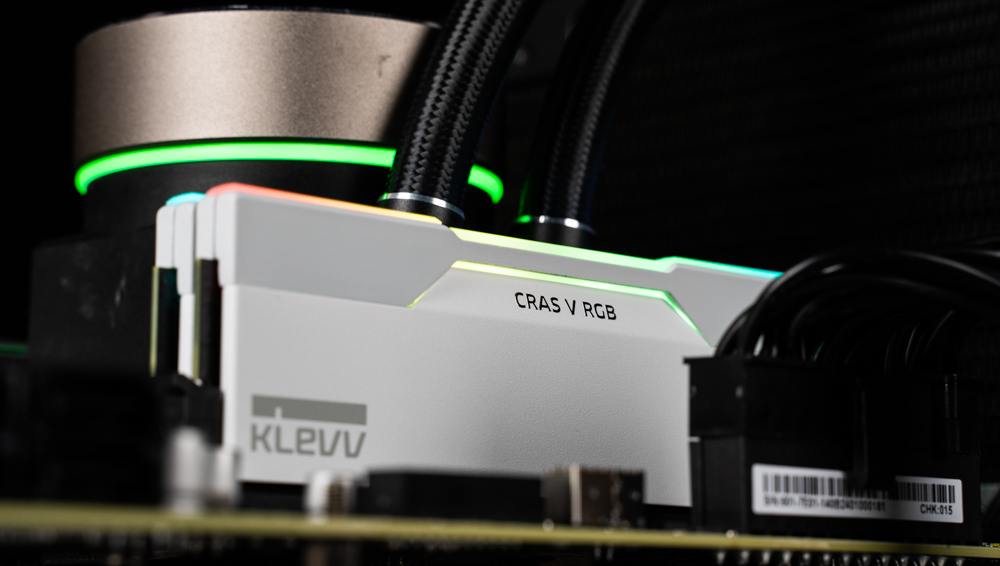
The photo highlights the KLEVV CRAS V RGB DDR5 memory modules in action, emphasizing their linear hollowed-out design, which not only adds a distinctive aesthetic to the memory sticks but also serves as a conduit for the RGB lighting. This design allows the light to be visible from multiple angles, enhancing the visual impact and creating a dynamic lighting display within the system’s case.
The RGB lighting appears to be finely diffused through the linear openings, resulting in a subtle yet impactful glow that can complement any custom PC build. It works in harmony with other illuminated components, like the CPU cooler in the background, which features a green glow, demonstrating how the CRAS V RGB modules can synchronize with a variety of color schemes to match the user’s preference or theme.
The ability to integrate these memory modules into a broader RGB ecosystem, coordinating with other RGB-enabled components, highlights their appeal to users who value both performance and an immersive aesthetic experience in their computing environments.
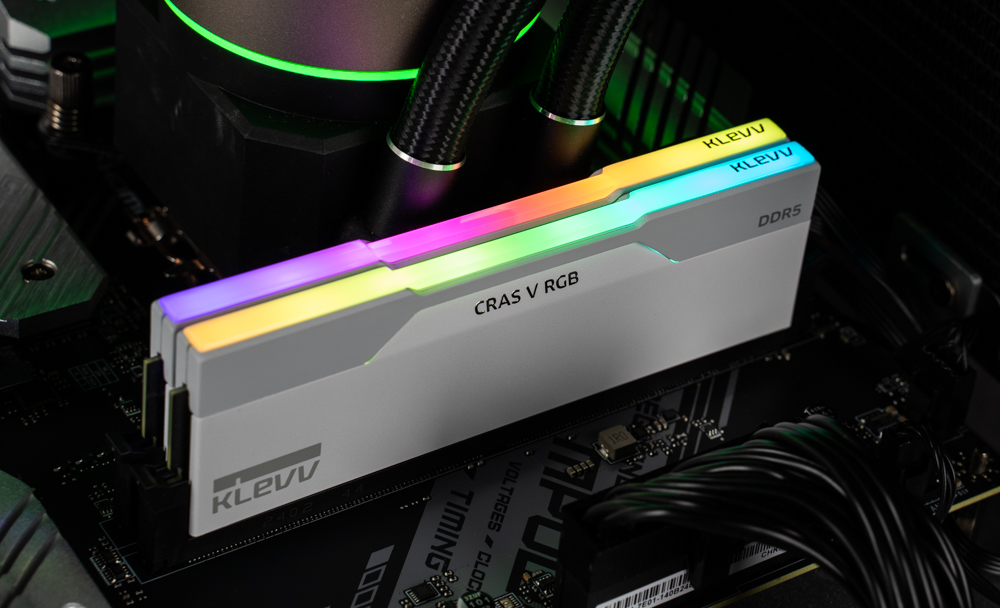
This image captures the KLEVV CRAS V RGB DDR5 memory modules in a vibrant display of their RGB capabilities. The lighting gracefully transitions through a spectrum of colors, adding a dynamic and visually striking element to the system’s build. This feature isn’t just for show; it often serves to reflect the personality or style of the user, allowing them to customize their setup according to their preferences.
The smooth flow of colors across the top bar of the memory sticks accentuates the meticulous design and engineering that went into creating a product that enhances both performance and aesthetic appeal. The KLEVV modules are installed in a motherboard that complements the modules’ lighting, with surrounding components also featuring their own subtle lighting effects, contributing to a cohesive and attractive overall look.
This kind of RGB lighting is popular among PC builders and gamers for its ability to create an immersive environment, especially when paired with transparent or tempered glass PC cases that showcase the internal components. The CRAS V RGB modules, with their high-speed performance and brilliant lighting, represent a harmonious blend of form and function, making them a coveted choice for any high-end PC setup.
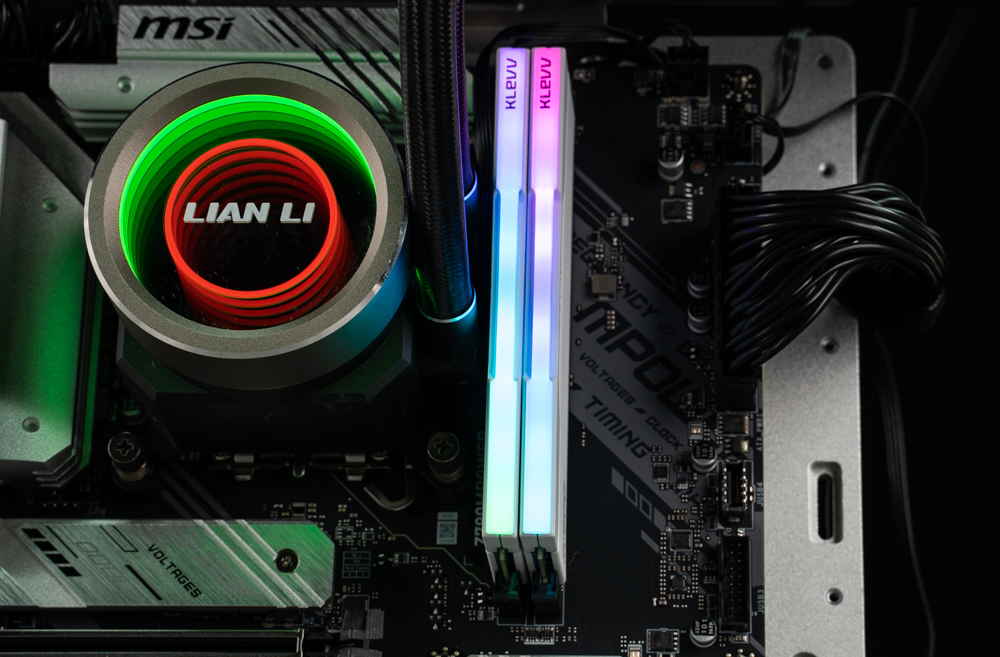
From this top-down perspective, we get a clear view of the KLEVV CRAS V RGB DDR5 memory modules installed on the motherboard, sitting alongside a striking CPU cooler from Lian Li, which displays its own colorful RGB lighting. The setup exudes a high-tech feel, with each component contributing to the overall aesthetic of the machine.
The harmonious synchronization of RGB lighting between the memory modules and the CPU cooler is evident, showcasing a palette that can be customized to the user’s liking. This synchronization isn’t just visually appealing; it’s also a sign of a well-integrated system where components from different manufacturers work together seamlessly, thanks to standardized RGB technology that can be controlled via software.
In the context of the motherboard, the CRAS V RGB modules are highlighted, not just for their performance, but also for their contribution to the system’s ambiance. Such setups are often a centerpiece of gaming rigs, streaming setups, or high-performance workstations, where the visual impact is as important as the technical specifications.
Maximizing Performance: Comprehensive Review of KLEVV CRAS V RGB DDR5 Memory with Intel i9 and MSI Z790MPOWER
For this memory test, the setup includes an Intel i9-14900K CPU and an MSI Z790MPOWER motherboard, focusing on evaluating the performance across standard JEDEC frequencies, XMP (Extreme Memory Profile) overclocking, and manual overclocking adjustments with the Memory Controller set at a 1:2 ratio. Other motherboard settings are left on Auto to ensure the default operating conditions do not influence the test results.
It’s important to note that earlier DDR5 motherboards might not support such high frequencies as provided by the latest modules. Prior to use, users should verify compatibility through the motherboard’s Qualified Vendor List (QVL) to confirm that the memory is tested and proven to work with their specific board model. Updating to the latest BIOS version is crucial to ensure optimal stability and performance. BIOS updates often include improvements and bug fixes that can enhance memory compatibility and allow the system to take full advantage of the high-speed capabilities of new memory modules like these. Users aiming to achieve the best possible outcomes in terms of system stability and memory performance should follow these recommendations carefully.
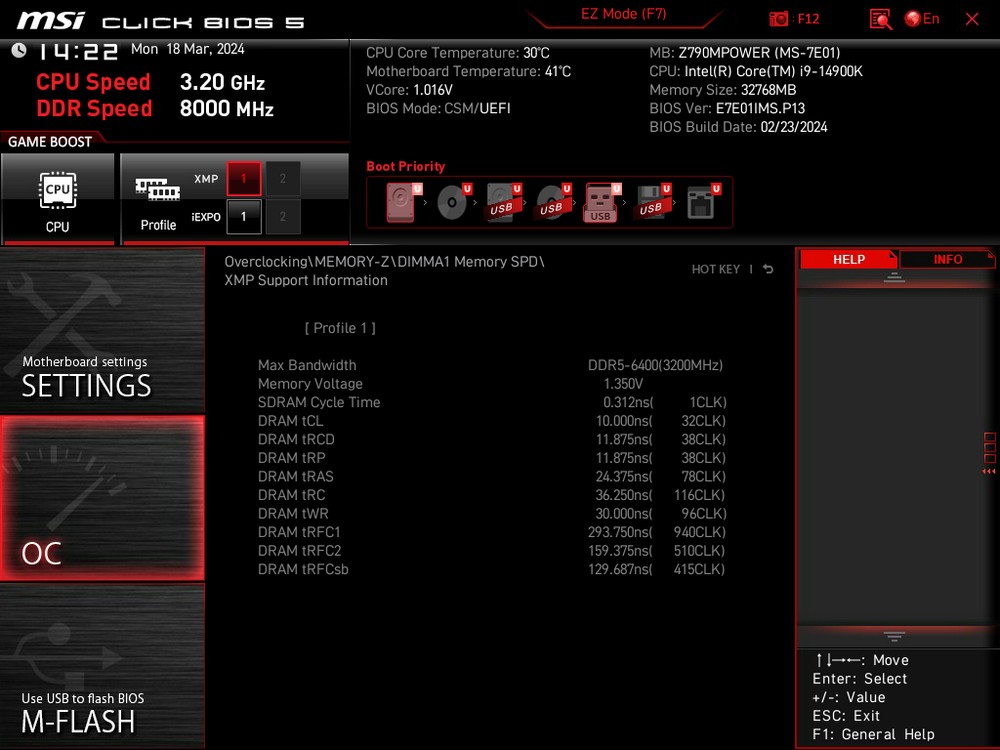
A screenshot of an MSI motherboard’s BIOS interface, specifically the MSI Click BIOS 5, showing an overclocking profile for DDR5 memory. The BIOS is displaying settings related to the XMP (Extreme Memory Profile) which is a feature used to overclock memory beyond its standard specifications to achieve higher performance.
In the screenshot, we can see that the DDR5 memory is set to operate at a frequency of 6400MHz, which is essentially doubled to an effective 32000MHz due to DDR (Double Data Rate) memory’s ability to transfer data on both the rising and falling edges of the clock signal.
The timings section lists the latency settings for the RAM, which are important for its operation and performance:
- SDRAM Cycle Time (tCL, tRCD, tRP, tRAS): These are primary timings that indicate how many clock cycles it takes for certain memory operations to be completed.
- DRAM tRC: This is the row cycle time, the minimum number of clock cycles required for a complete row cycle in memory.
- DRAM tWR, tRFC1, tRFC2, tRFC4: These are secondary timings related to write recovery time and row refresh cycle times for different sizes of operation.
- DRAM tRFCsb: This is the row refresh cycle time for same bank groups.
The left side of the screen shows the CPU speed and DDR speed, highlighting that the memory is running at the overclocked speed of 8000MHz, which is an impressive figure for DDR5 RAM.
Please note that the settings in the BIOS should be adjusted by someone who is knowledgeable about overclocking and the implications it has on system stability and component longevity. Overclocking can lead to higher performance but also increased heat and potential stress on the hardware, which might require additional cooling solutions and can impact the overall lifespan of the components.
Testing Platform :
Processor: Intel Core i9-14900K
Motherboard: MSI Z790MPOWER
Radiator: Lian Li GALAHAD II PERFORMANCE 360
Operating system: Windows 11 Professional 23H2
Power supply: LEADEX VII 1000W
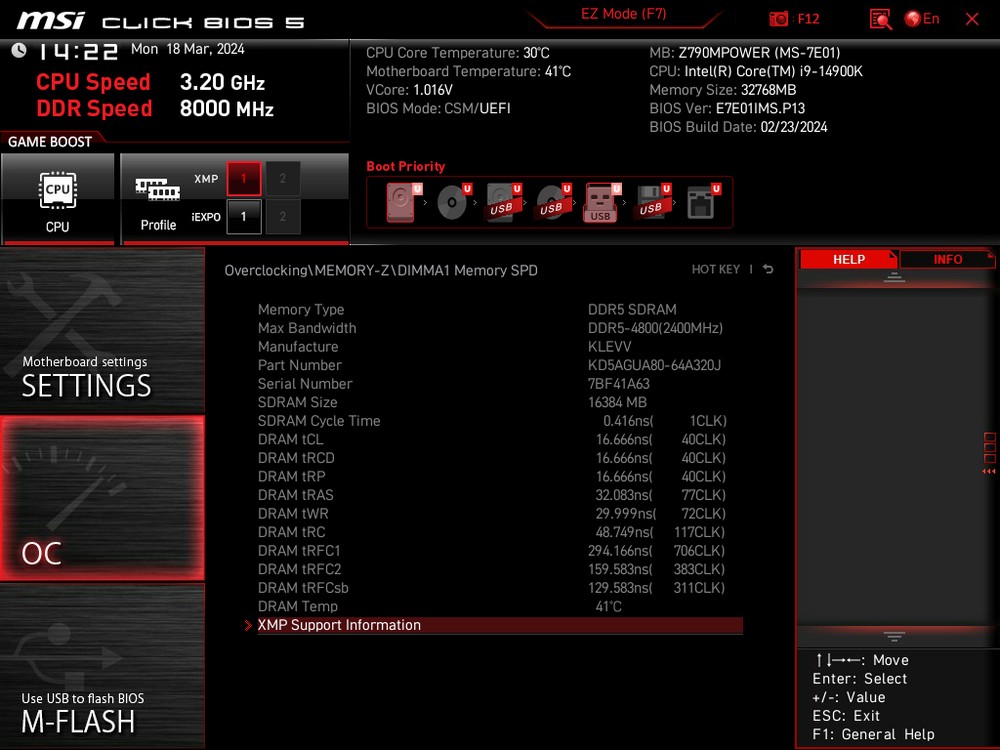
From the BIOS shows the SPD (Serial Presence Detect) information for the KLEVV CRAS V RGB DDR5 memory, which contains pre-programmed settings for the memory modules. The SPD is essential for motherboard and CPU compatibility as it communicates the memory specifications to the system upon boot.
Here are the details presented in the BIOS:
- JEDEC Standard Timing: The memory’s standard timing set by JEDEC (the Joint Electron Device Engineering Council) is programmed to run at 4800MT/s with timings of 40-40-40-77 and a command rate (tRC) of 117 at a voltage of 1.1V. These settings are the default operational parameters for DDR5 memory as established by the regulatory body and ensure compatibility across different systems.
- XMP Profile: The Extreme Memory Profile (XMP) for this KLEVV memory is an overclocked setting, allowing the memory to function at 6400MT/s with timings of 32-38-38-78 and a command rate of 116 at a voltage of 1.35V. XMP profiles are designed by the memory manufacturers to enable higher performance by automatically configuring the motherboard with these faster settings, provided the system supports XMP and the user enables it in the BIOS.
The BIOS also reflects the memory’s SDRAM size, which is 16GB per module, and the DRAM temperature, indicating a normal operational status at 41°C. This information helps users understand the performance potential and the operating conditions of their memory modules.
Users who want to leverage the higher speeds provided by the XMP profile should ensure their system is capable of handling the increased voltage and has adequate cooling to maintain optimal temperatures. It’s also important to verify that the motherboard supports the XMP profile and that the latest BIOS version is installed for the best compatibility and performance.
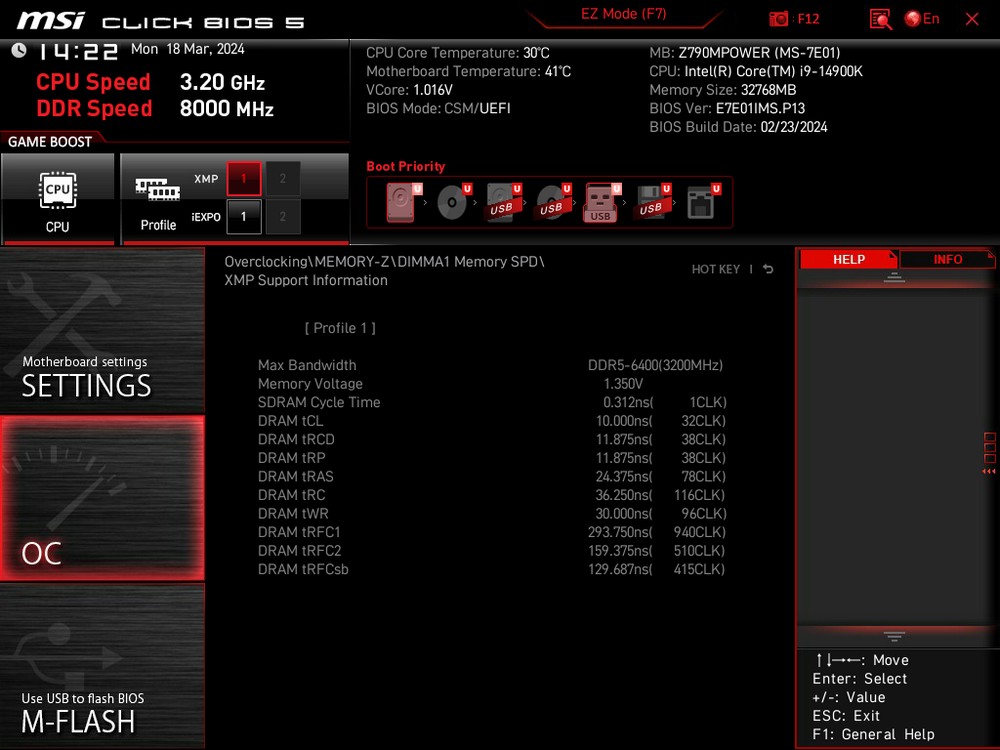
In this BIOS screenshot, we see the XMP (Extreme Memory Profile) information for the installed DDR5 memory modules, specifically designed for overclocking and enhancing performance beyond the standard specifications.
Here’s a breakdown of the details provided:
- Max Bandwidth: This refers to the theoretical maximum transfer rate of the memory. The DDR5-6400 specification indicates the memory can achieve up to 6400MT/s, which translates to an effective 3200MHz since DDR (Double Data Rate) transfers data twice per clock cycle.
- Memory Voltage: For the XMP profile, the memory operates at 1.35V, which is higher than the standard JEDEC voltage for DDR5 (usually around 1.1V), allowing the memory to maintain stability at higher speeds.
- SDRAM Cycle Time: The timings are listed as 31.25ns (nanoseconds), which is a representation of the duration of one cycle at the operating frequency.
- DRAM Timings (tCL, tRCD, tRP, tRAS): These primary timings are set to 32 cycles (tCL), 38 cycles (tRCD), 38 cycles (tRP), and 78 cycles (tRAS), respectively, which dictate how many clock cycles certain operations take to complete. The lower these numbers, the faster the memory can access data.
- DRAM tRC: The row cycle time is at 116 cycles, representing the number of clock cycles needed for a complete row cycle in memory.
- DRAM tWR, tRFC1, tRFC2, tRFC4, tRFCsb: These are secondary and tertiary timings related to the memory’s write recovery time and row refresh cycle times, essential for maintaining data integrity and performance during high-speed operations.
This information is crucial for enthusiasts and professionals who want to ensure they are getting the most out of their high-performance memory modules. By selecting the XMP profile in the BIOS, the system automatically adjusts to these optimized settings, which are tested and verified by the memory manufacturer, ensuring both enhanced performance and stability.
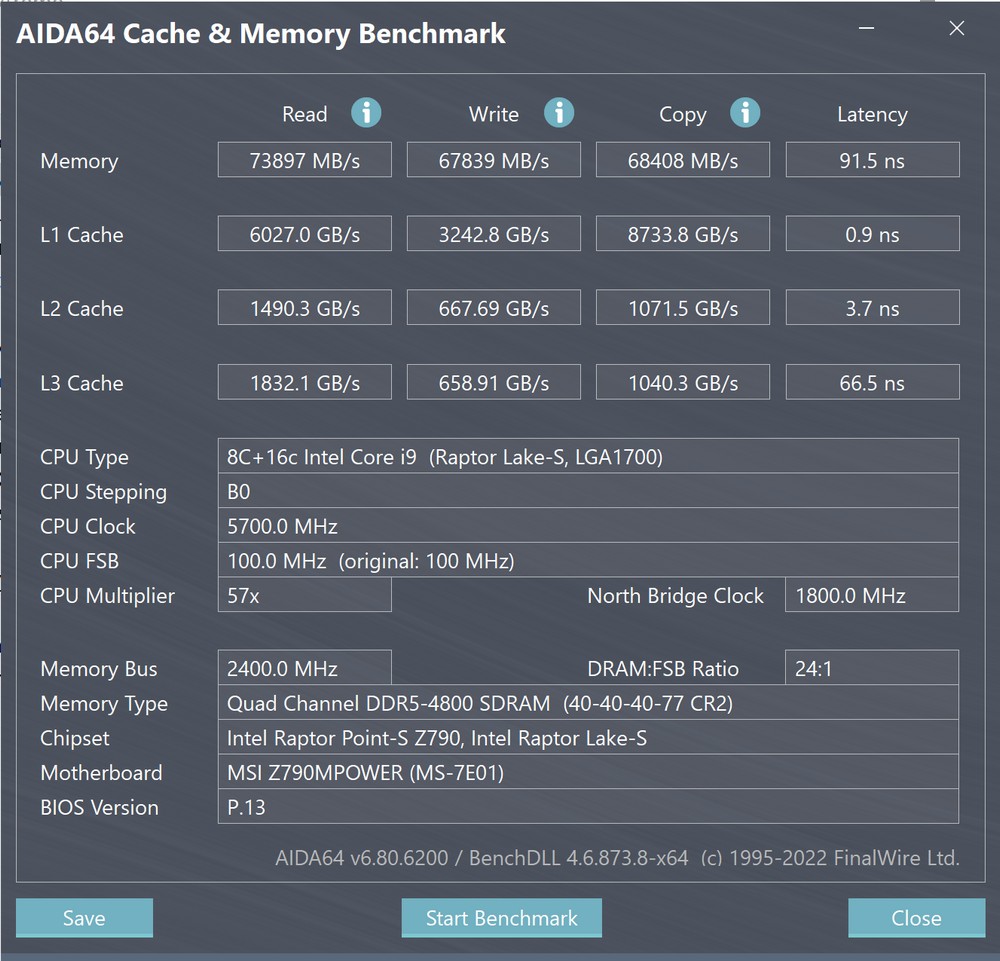
The results of an AIDA64 Cache & Memory Benchmark test. The memory performance was evaluated at the JEDEC standard frequency of 4800MT/s, which is the default speed without any XMP (Extreme Memory Profile) overclocking enabled.
Here are the key points from the benchmark:
- Memory Read: 73897 MB/s
- Memory Write: 67839 MB/s
- Memory Copy: 68408 MB/s
- Latency: 91.5 nanoseconds
These results provide insight into how the memory performs under standard conditions. The read, write, and copy speeds are important indicators of how quickly the memory can handle data operations. The latency figure represents the delay between when a memory operation is requested and when it is executed; lower latency generally contributes to a more responsive system.
The benchmark also details the system’s configuration, including:
- CPU Type: An 8-core, 16-thread Intel Core i9 from the Raptor Lake-S family, with a clock speed of 5700 MHz.
- Memory Bus: Operating at 2400.0 MHz, which effectively becomes 4800MT/s due to Double Data Rate (DDR).
- Memory Type: Quad-channel DDR5-4800 SDRAM with timings set at 40-40-40-77 CR2.
- Chipset and Motherboard: Intel Raptor Point-S Z790 chipset on an MSI Z790MPOWER motherboard.
These numbers are very respectable for JEDEC standards, but engaging the XMP profile would likely yield significantly higher throughput and potentially lower latency due to the increased clock speeds and tightened timings, taking full advantage of the memory kit’s capabilities. For users looking to optimize performance, particularly in bandwidth-intensive applications or workloads, enabling XMP can make a considerable difference.
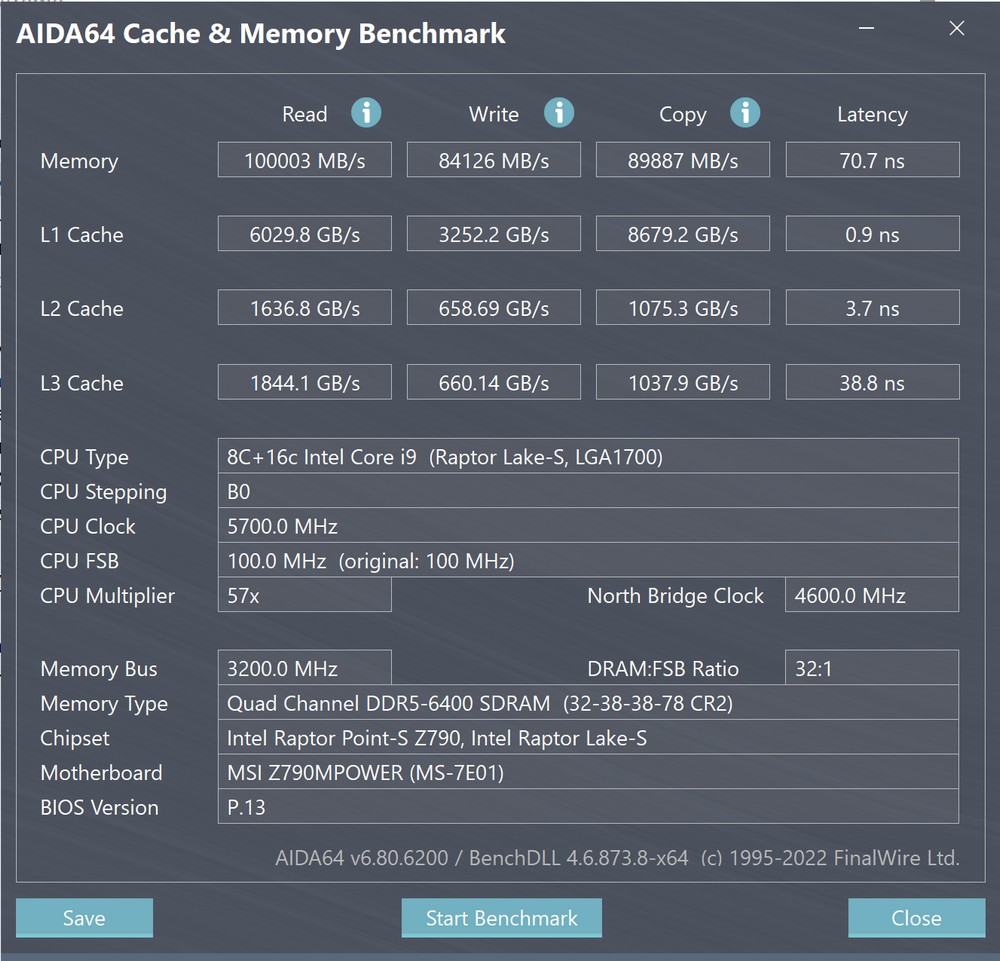
The results from the AIDA64 Cache & Memory Benchmark with XMP enabled are indeed impressive, showcasing a significant performance boost when the memory operates at the overclocked speed of 6400MT/s. Here’s the summarized data from the test with XMP turned on:
- Memory Read: 100003 MB/s
- Memory Write: 84126 MB/s
- Memory Copy: 89887 MB/s
- Latency: 70.7 nanoseconds
Enabling XMP has led to a substantial increase in read and write speeds compared to the JEDEC standard frequencies, as well as a noticeable decrease in latency. These enhancements in memory performance are critical for applications that demand high bandwidth and quick access to data, such as video editing, 3D rendering, and gaming, especially in high-resolution or competitive scenarios where every millisecond counts.
The improvement in memory latency is particularly noteworthy, dropping from 91.5ns to 70.7ns, which contributes to a more responsive overall system. This reduction in latency can lead to smoother operation and improved performance in latency-sensitive tasks.
This benchmark highlights the tangible benefits of investing in high-frequency memory kits and the importance of enabling XMP to take full advantage of the memory’s capabilities. Without enabling XMP, users leave a significant amount of performance on the table, as the memory would operate at a lower default speed. Therefore, for users who aim to maximize their system’s potential, enabling XMP is indeed essential, and this example perfectly illustrates the potential gains.
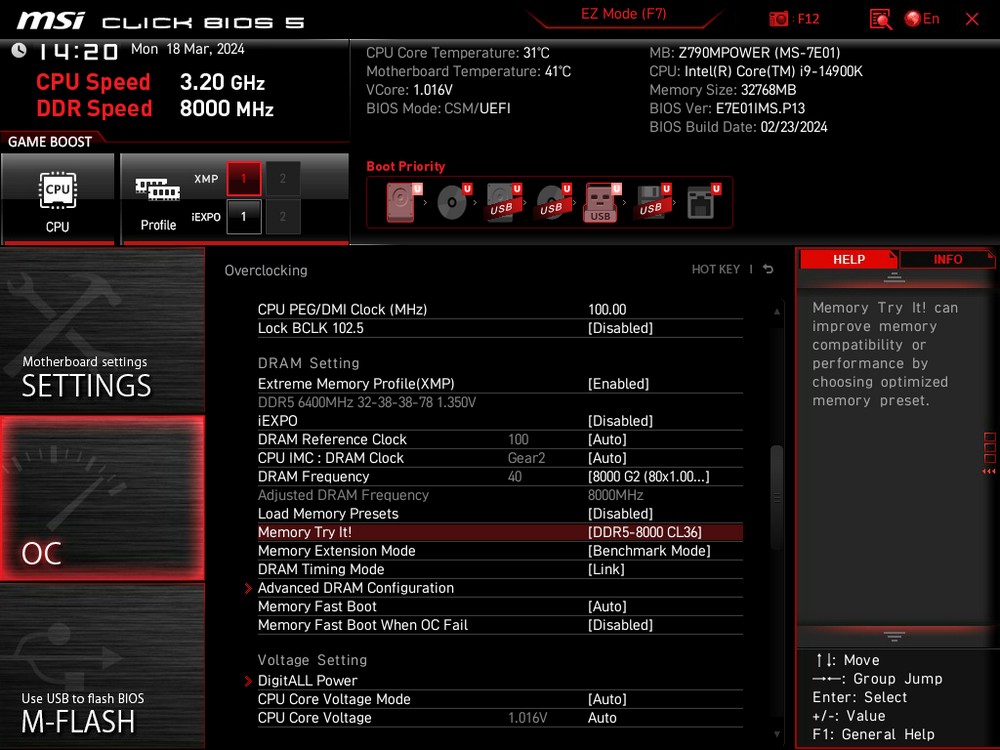
This BIOS screenshot displays the overclocking settings being applied to the KLEVV CRAS V RGB DDR5 memory on the MSI Z790MPOWER motherboard. This board is specifically designed for overclocking, with features that cater to enthusiasts looking to push their hardware to its limits. Here’s a summary of the key points mentioned:
- The MSI Z790MPOWER motherboard is equipped with a dual-slot, 1DPC (one DIMM per channel) memory design, which generally allows for higher overclocking headroom compared to multi-DPC configurations. This design is conducive to achieving high memory speeds and is often preferred by overclockers.
- The motherboard also includes a built-in clock generator, which can allow Non-K series CPUs to achieve higher performance through BCLK (base clock) overclocking, which is a method of increasing the processor’s operating frequency.
- The Memory Try It! feature in the BIOS offers users pre-configured overclocking profiles for memory, enabling quick and easy tuning without the need for detailed manual adjustments. This tool is part of MSI’s initiative to assist users in finding the maximum stable overclock for their memory modules.
- KLEVV has partnered with MSI as part of the “Dragon Alliance,” a research effort by MSI geared towards extreme memory overclocking. This collaboration goes beyond standard QVL testing to develop optimized configurations tailored for overclocking. The CRAS V RGB is one of the first memory products certified under this initiative.
- In this test, the Memory Try It! function is used to overclock the memory to 8000MT/s at CL36 latency, which is pushing the bounds of normal memory overclocking. Pushing beyond this point is not only a test of the memory’s capabilities but also depends on the memory controller within the CPU.
- The BIOS’s Memory Extension Side feature, set to “Benchmark Mode,” presumably adjusts settings to further optimize performance for benchmarking purposes.
It’s important to note that extreme overclocking, such as pushing memory to 8000MT/s, can significantly stress both the memory modules and the memory controller on the CPU, which may impact system stability and the longevity of the components. Cooling solutions and ensuring a stable power supply are critical in such scenarios. Users should proceed with caution and have a good understanding of the risks involved with overclocking to such extents.
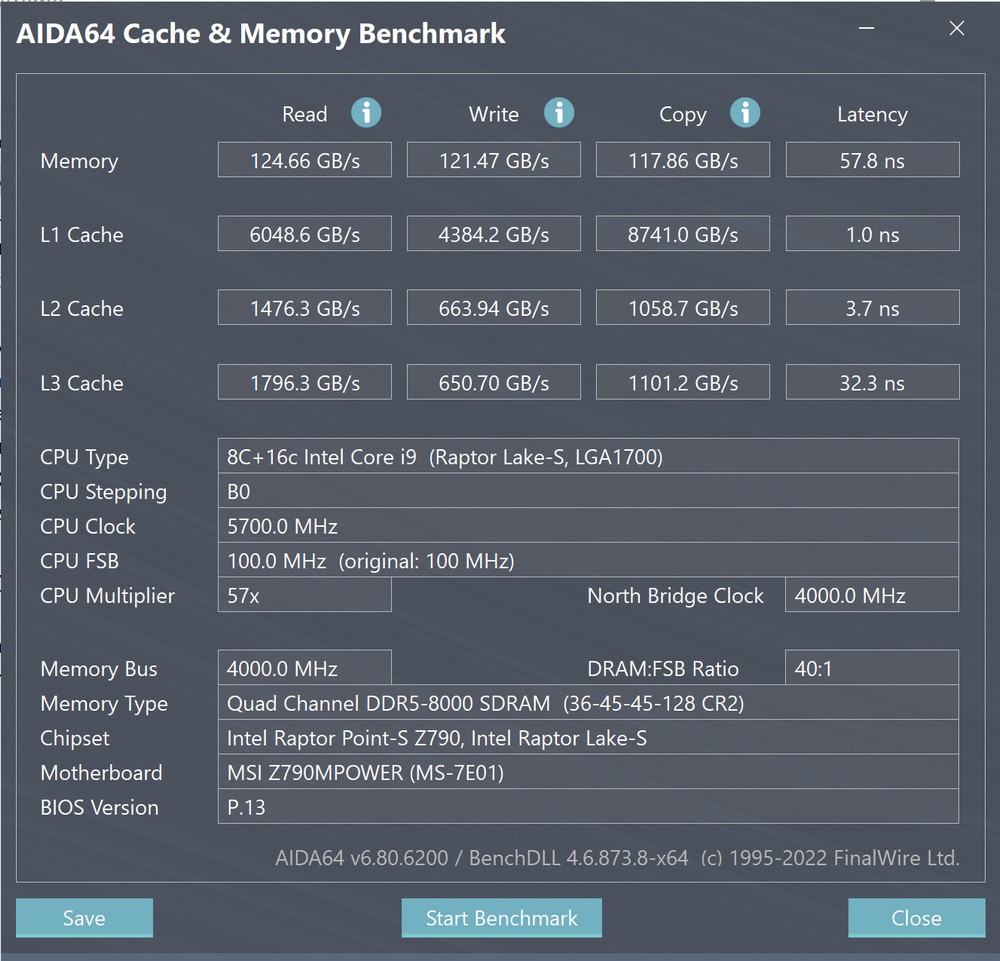
The AIDA64 Cache & Memory Benchmark screenshot demonstrates the performance of the memory overclocked to 8000MT/s. Here’s a summary of the impressive results achieved:
- Memory Read: 124.66 GB/s
- Memory Write: 121.47 GB/s
- Memory Copy: 117.86 GB/s
- Latency: 57.8 nanoseconds
Overclocking to 8000MT/s has resulted in exceptionally high read, write, and copy speeds. These speeds are significantly greater than what you would see with standard DDR5 speeds, indicating that the memory is performing exceptionally well at the overclocked frequency.
The latency of 57.8 ns is also notably lower compared to the standard JEDEC profiles, indicating a quicker response time for memory operations, which can result in a smoother computing experience, particularly in performance-sensitive applications.
The system specifications provided in the benchmark are as follows:
- CPU Type: 8-Core, 16-Thread Intel Core i9 (Raptor Lake-S, LGA1700)
- CPU Clock: 5700 MHz
- Memory Bus: 4000.0 MHz, effectively doubled to 8000MT/s due to DDR (Double Data Rate)
- Memory Type: Quad Channel DDR5-8000 SDRAM with timings of 36-45-45-128 CR2
- Chipset/Motherboard: Intel Raptor Point-S Z790 on an MSI Z790MPOWER motherboard
This test confirms that the KLEVV CRAS V RGB DDR5 memory is capable of reaching high overclocked speeds, pushing the boundaries of what’s achievable with consumer DDR5 memory. It’s worth noting that the memory’s performance can vary based on the system configuration, including the CPU’s memory controller and the quality of the motherboard’s circuitry.
Users should be aware that while overclocking can offer substantial performance benefits, it may also affect system stability and component longevity. Adequate cooling and power supply quality are critical when operating at such high frequencies.
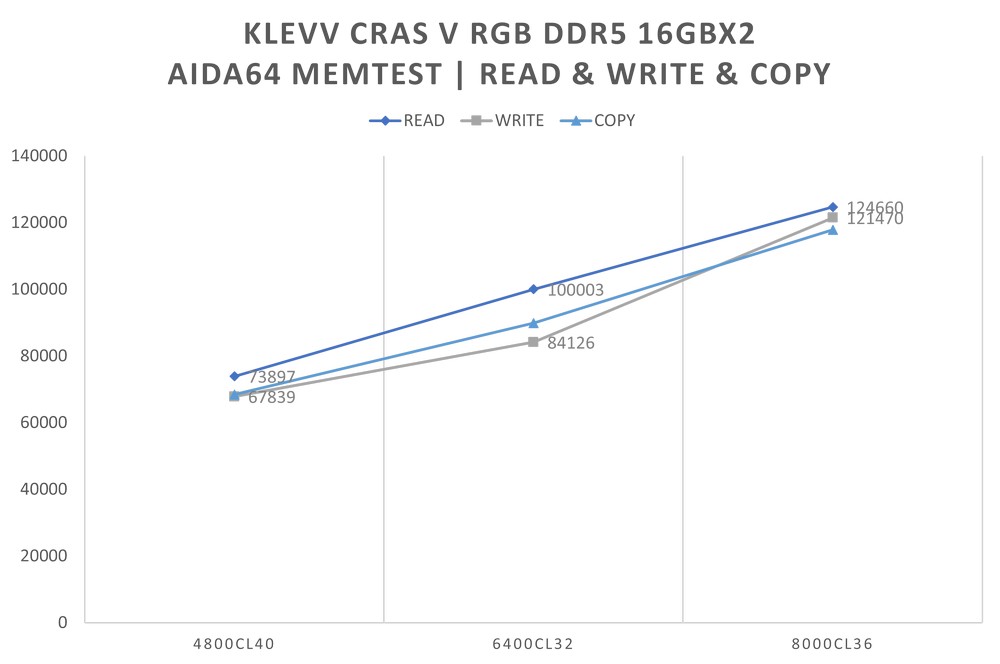
The graph visualizes the read, write, and copy performance of the KLEVV CRAS V RGB DDR5 16GBx2 memory kit across different speed and latency settings. The X-axis represents the speed and latency configurations, while the Y-axis represents the data transfer rates in MB/s.
Here’s a quick analysis of the performance data shown:
- At 4800CL40 (JEDEC standard timings and frequency), the performance is at its baseline with the lowest transfer rates.
- When the memory is set to 6400CL32 (XMP profile), there is a substantial increase in performance, showcasing the benefits of enabling XMP for higher speeds and tighter (lower) latencies.
- At the 8000CL36 configuration (manual overclocking), the graph shows the highest performance, with the read speed exceeding 124,000 MB/s, write speed above 121,000 MB/s, and copy speed just under 118,000 MB/s. These are remarkable figures that illustrate the potential of high-frequency DDR5 memory when overclocked.
The data points make it clear that as the speed increases and the latency decreases, there’s a significant improvement in memory performance. This performance scaling is particularly important for tasks that are sensitive to memory speeds, such as high-resolution video editing, large dataset analysis, and intensive gaming.
This graph serves as a valuable reference for anyone considering overclocking their memory, as it visually presents the tangible gains that can be expected from pushing the memory beyond its base specifications. It also underscores the importance of ensuring that all other system components, particularly the CPU and motherboard, are capable of supporting such high memory speeds for the overclock to be stable and effective.
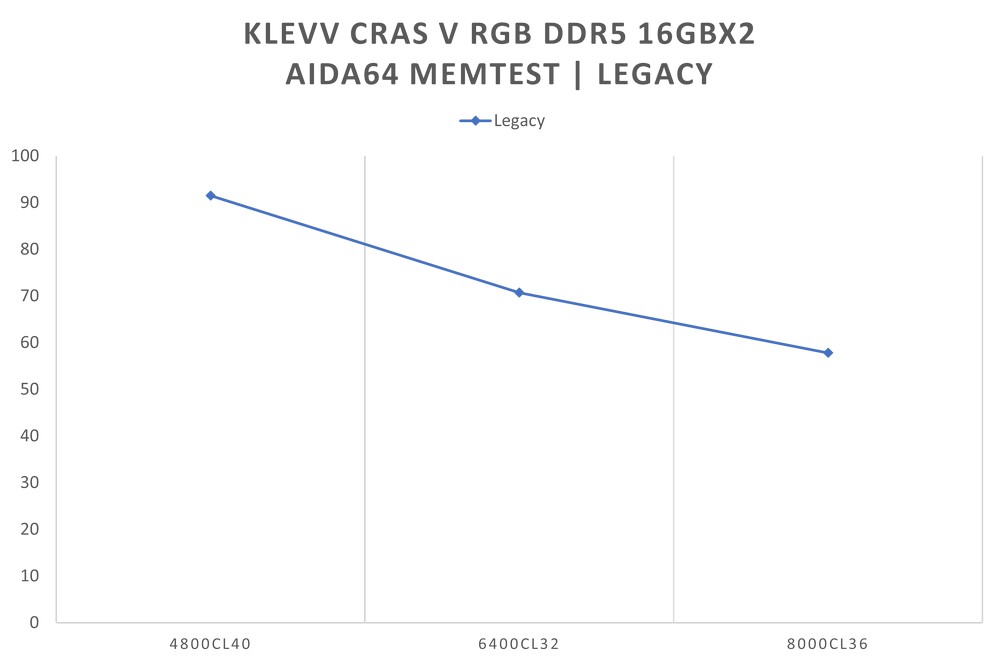
This graph presents a comparison of memory latency across different speed and latency configurations for the KLEVV CRAS V RGB DDR5 16GBx2 memory kit, measured in nanoseconds (ns).
- At 4800CL40 (JEDEC standard), the latency starts off the highest on the graph at around 91.5ns.
- With 6400CL32 (enabled XMP profile), we see a decrease in latency to around 70.7ns.
- The lowest latency is observed at 8000CL36 (manual overclocking), where it further reduces to approximately 57.8ns.
Latency is an important metric in memory performance because it measures the time it takes for a memory request to be completed after it’s been issued. Lower latency can result in a more responsive and faster system, especially in tasks where quick memory access is crucial, such as in gaming or real-time data processing.
The downward trend shown in the graph illustrates the inverse relationship between memory speed and latency; as the operational frequency of the memory increases (with corresponding adjustments in timings), the latency typically decreases. This graph is a clear visual representation of how enabling XMP profiles and manual overclocking can lead to reduced latency and thus enhanced system performance.
Using PerformanceTest to assess memory performance is a comprehensive way to understand how well memory modules perform under various conditions, particularly for tasks that mimic real-world usage. PerformanceTest by PassMark evaluates memory by simulating different scenarios:
- Database Operations: This test simulates how memory performs during database processing, which can be intense on memory read/write operations and benefits from both high speeds and low latency.
- Memory Read (with Cache On/Off): It measures the speed at which the memory can be read. The test with the cache turned off is particularly telling of the true performance of the memory, as it bypasses the CPU’s cache, which is significantly faster but limited in size.
- Memory Write: This determines how quickly the memory can handle write operations, which is important for tasks such as video rendering or large file manipulations.
- Latency: This is the delay between a request for a byte or word in memory and when it is delivered to the CPU. Latency impacts overall system responsiveness, especially in applications requiring frequent memory access.
- Capacity: While not a performance metric per se, having enough memory capacity is crucial for multitasking and running memory-intensive applications without slowdowns or the need to use slower disk-based virtual memory.
- Threaded Memory Allocation: This tests the memory’s performance in a multi-threaded environment, where multiple threads or processes might be allocating and accessing memory simultaneously. This is reflective of modern multitasking operating systems and workloads.
When using PerformanceTest, it’s good to run multiple passes to get an average score, as performance can fluctuate slightly with each run. These tests will give a well-rounded picture of how the KLEVV CRAS V RGB DDR5 performs across different types of workloads, providing valuable data for users who need their systems to perform well in specific applications.
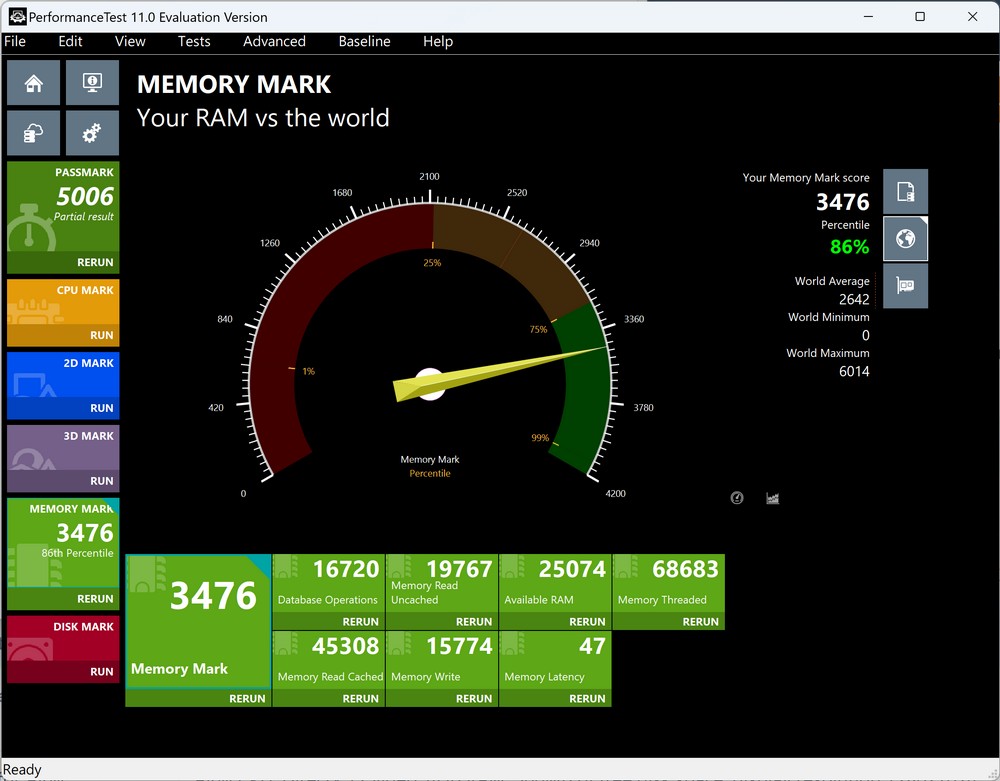
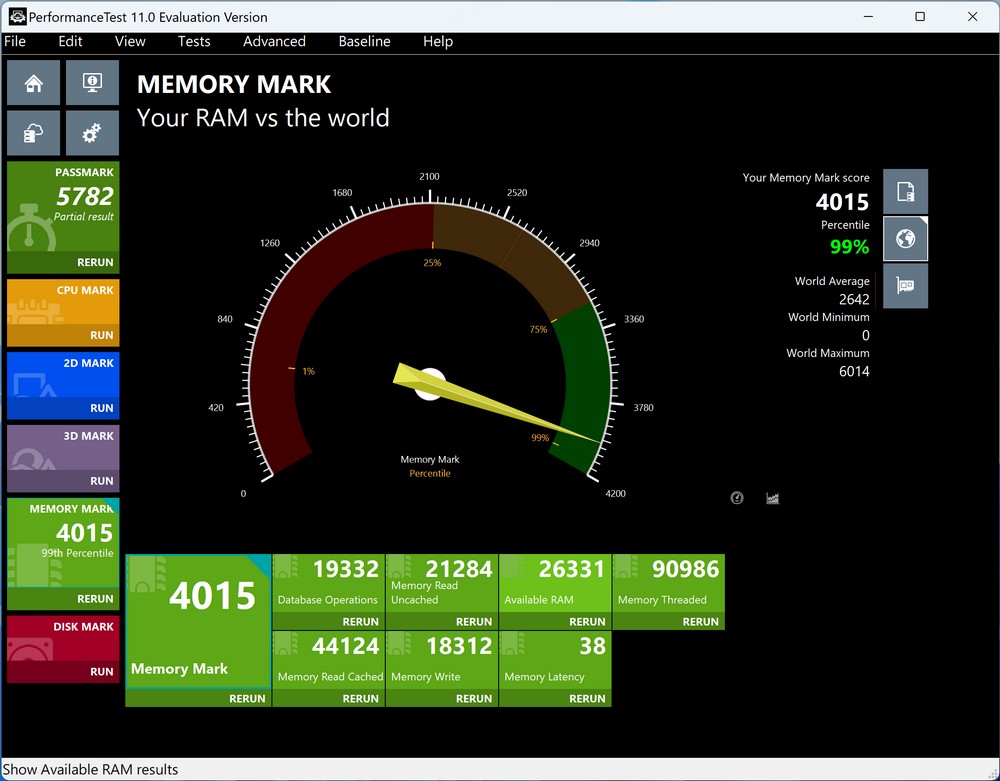
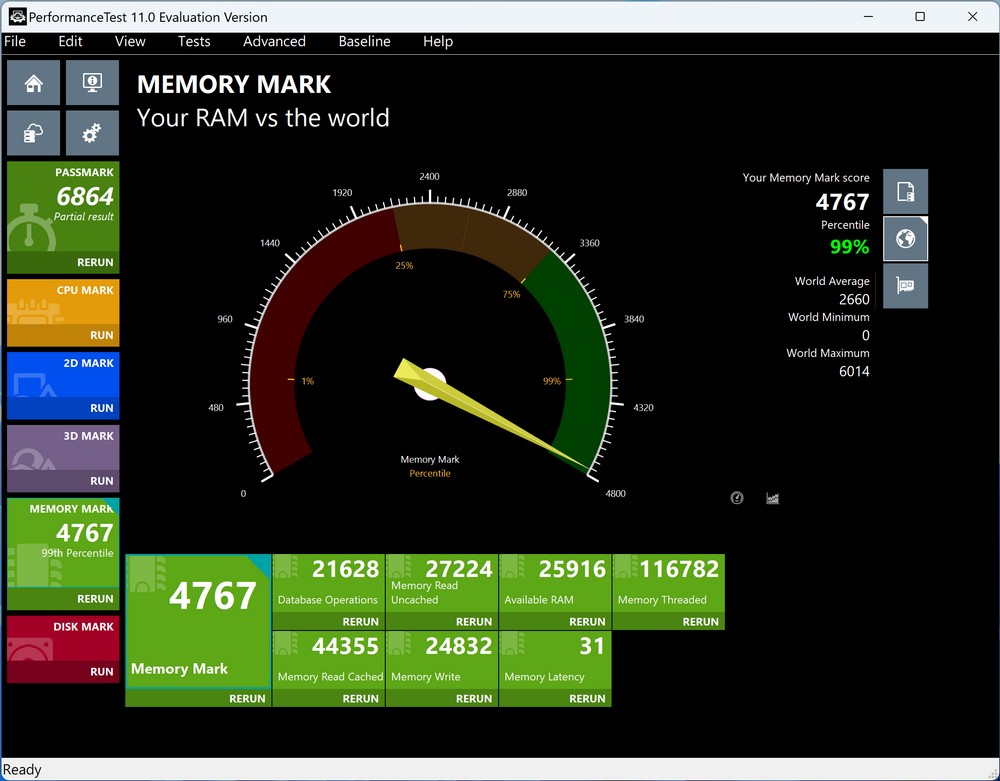
These screenshots show the PerformanceTest memory benchmarks for the KLEVV CRAS V RGB DDR5 16GBx2 memory at various configurations:
- JEDEC Standard: The first screenshot likely represents the benchmark result at the JEDEC standard speed of 4800MT/s. The total Memory Mark score is 3476, placing the RAM in the 86th percentile compared to other systems worldwide.
- XMP Profile: The second screenshot shows a Memory Mark score of 4015 when the memory operates at the XMP profile of 6400MT/s, placing it in the 99th percentile, indicating that this memory kit performs better than 99% of the results in the world database for this benchmark.
- Manual Overclocking: The third screenshot appears to show the benchmark result after manually overclocking the memory to 8000MT/s, where it achieves a Memory Mark score of 4767, maintaining its position in the 99th percentile. This score represents a significant jump from the XMP results, demonstrating the memory’s exceptional overclocking capabilities.
Across the board, these results signify that the KLEVV CRAS V RGB DDR5 16GBx2 memory kit performs exceptionally well, especially when overclocked. Notably, the jump in performance from the JEDEC standard to XMP is substantial and further improved with manual overclocking to 8000MT/s. The percentile rankings give a clear indication that this memory kit is among the top-performing memory kits available, especially in overclocked conditions.
The benchmarks also cover various other memory-related tasks like database operations, read, write, cached, and uncached speeds, and memory latency. These comprehensive tests demonstrate the memory’s capabilities in different usage scenarios, which could be particularly beneficial for users with high-performance computing needs.
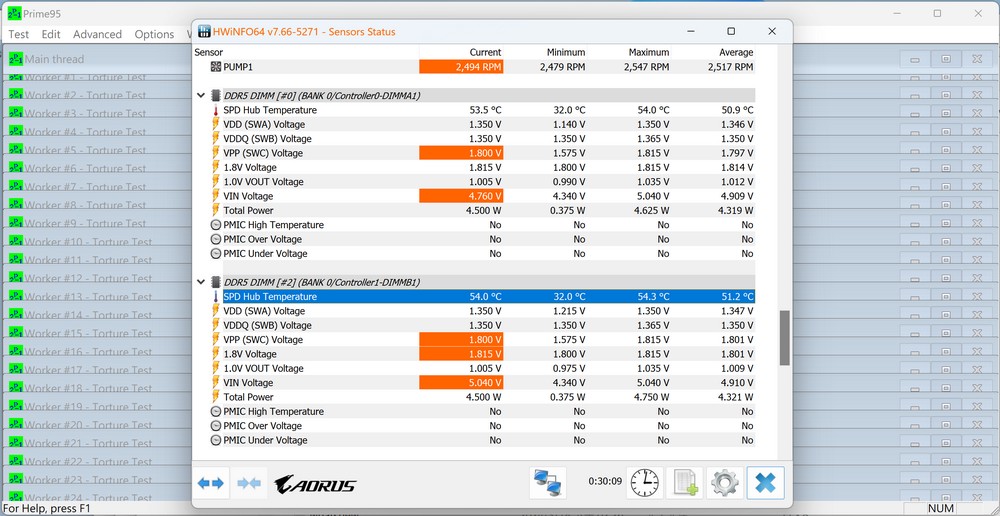
This screenshot shows HWiNFO64 monitoring the system while Prime95 Large FFTs stress test is running. Prime95 is known for its demanding load on the CPU and can indirectly affect memory temperatures due to increased system heat output. The test results indicate:
- The memory modules are operating at a 6400MT/s XMP profile.
- During a 30-minute stress test, the system is running stably.
- The maximum temperature recorded on the memory SPD hub is 54.3°C, with average temperatures hovering between 50-51°C.
These temperatures demonstrate the efficiency of the CRAS V RGB’s cooling solution, which incorporates a 2mm thick heat spreader. Such a heat spreader is designed to effectively dissipate heat, maintaining a stable operating temperature even under the stress of a workload like Prime95.
Memory temperature is an essential factor for stability and performance, especially when overclocking. The results indicate that the KLEVV CRAS V RGB memory modules are well within a safe thermal range during intense operation, which is a positive indicator for long-term durability and performance reliability.
The combination of the hardware’s thermal design, ambient case airflow, and the open test bench platform likely contributed to these favorable thermal performance results. For users looking to push their systems with overclocking while maintaining stability, the cooling efficacy of their memory modules is an important consideration, and in this case, the KLEVV memory appears to be well-equipped to handle the demands.
Summarize
In conclusion, the KLEVV CRAS V RGB DDR5 memory emerges as a high-performance solution, enabled by the support for one-click overclocking technologies like Intel XMP 3.0 and AMD EXPO. This convenience allows users to effortlessly tap into the benefits of high-frequency memory, significantly enhancing system performance.
The memory’s potential for overclocking is bolstered by the use of premium memory chips and a robust 10-layer PCB design. During tests with the MSI Z790MPOWER motherboard, the memory reached an impressive 8000MT/s. However, it’s important to note that the overclocking results can vary based on the quality of the memory chips, the CPU’s capabilities, and the motherboard’s overclocking features. Although KLEVV collaborates closely with leading motherboard manufacturers to ensure stability and compatibility at XMP profiles, individual results may vary, and the potential for reaching the highest overclocking speeds can’t be guaranteed for all setups.
The Crystal White color scheme of the KLEVV CRAS V RGB DDR5 caters to the aesthetic preferences of users who favor white-themed builds. The linear hollowed-out design subtly reveals the RGB lighting, adding a striking visual touch that can be synchronized and customized through motherboard lighting software, blending performance with style.
The KLEVV CRAS V RGB DDR5 is a memory product that does not compromise on aesthetics while providing robust performance, making it a top contender for gamers, enthusiasts, and PC builders who seek to combine peak functionality with a personalized look for their high-end systems.
If this article is helpful for you, please share this article with your friends on social media. Thank you!
This article is based on the personality of the reviews. You are responsible for fact-checking if the contents are not facts or accurate.
Title: Unlock Extreme Speeds with KLEVV CRAS V RGB DDR5: The Ultimate 8400MT/s Memory for Gaming and Overclocking